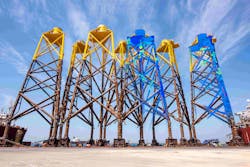Digital twin technology improves offshore wind jacket design
Offshore staff
LAUSANNE, Switzerland – Akselos and Lamprell have announced the results of an EU-backed wind foundation design project, proving that predictive digital twin technology can reduce the steel weight and associated costs of offshore wind jacket foundations by up to 30%.
The European Union awarded Akselos E1.4 million ($1.7 million) in 2018 to conduct the research and pilot project GODESS - Global Optimal Design of Support Structures. The GODESS philosophy has been used as the basis for proof of concept on one of Lamprell’s UK offshore wind projects.
Lamprell will now apply the findings to reduce the amount of steel it uses to construct its offshore foundations.
The results were achieved thanks to Akselos’ MIT-licensed simulation technology reduced basis finite element analysis (RB-FEA), that allows for speed and accuracy through real-time data feeds. For Lamprell, that enables highly accelerated design workflows where multiple design alternatives can be tested against thousands of scenarios in minutes, and in high fidelity.
Lamprell CEO Christopher McDonald said: “We are delighted at the results we’ve seen with Akselos’ digital twins which provide a true step-change in our design process. With their state-of-the-art high-fidelity models, we’ve been able to reduce the steel weight in jacket foundation design and construction by up to 30%. This represents a significant reduction and saving; providing substantial value for our customers and wider stakeholders.
“Through our Digital business unit, we are focused on harnessing digital technologies to optimize multiple aspects of our operations.”
The research will continue by creating a full digital loop from design to operations, the companies said. This brings together parametric simulations, machine learning, and optimization routines to enable engineers to use relevant operational data to understand how designs behave under operating conditions, allowing for resilient, optimal designs based on real-world data.
Akselos CEO Thomas Leurent said: “Our mission is to speed up the deployment of mass-scale offshore wind by ensuring that the design process is as optimized as possible. The pilot project has shown just how much over-conservatism exists in the current design process, and the astonishing amount of value that can be realized by adopting emerging technologies like our digital twins.”
Lamprell is also applying the technology to the design of oil and gas installation foundations. So far, the company has seen a 10% reduction in weight.
The research was conducted with Eurostars, which is co-funded by the State Secretariat for Education, Research and Innovation and the EU.
07/12/2021
